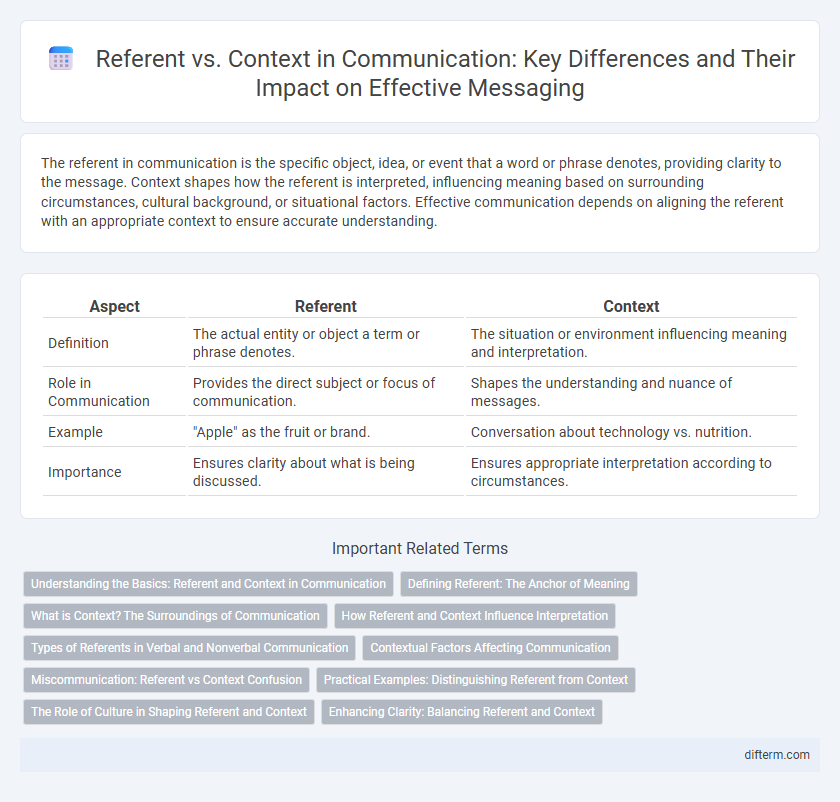The referent in communication is the specific object, idea, or event that a word or phrase denotes, providing clarity to the message. Context shapes how the referent is interpreted, influencing meaning based on surrounding circumstances, cultural background, or situational factors. Effective communication depends on aligning the referent with an appropriate context to ensure accurate understanding.
Table of Comparison
| Aspect | Referent | Context |
|---|---|---|
| Definition | The actual entity or object a term or phrase denotes. | The situation or environment influencing meaning and interpretation. |
| Role in Communication | Provides the direct subject or focus of communication. | Shapes the understanding and nuance of messages. |
| Example | "Apple" as the fruit or brand. | Conversation about technology vs. nutrition. |
| Importance | Ensures clarity about what is being discussed. | Ensures appropriate interpretation according to circumstances. |
Understanding the Basics: Referent and Context in Communication
Referent in communication refers to the actual object, event, or concept that a word or phrase denotes, forming the foundation of meaning. Context encompasses the surrounding circumstances, including physical setting, cultural background, and conversational environment, which influence the interpretation of the referent. Mastering the interplay between referent and context is essential for effective communication, ensuring accurate transmission and reception of intended messages.
Defining Referent: The Anchor of Meaning
The referent serves as the anchor of meaning in communication, representing the specific object, concept, or entity a word or phrase denotes. Its clarity allows the receiver to accurately interpret the intended message by linking linguistic symbols to real-world or abstract entities. Context shapes how the referent is understood, but the referent itself remains the stable focal point that grounds meaning and prevents ambiguity.
What is Context? The Surroundings of Communication
Context refers to the environment and conditions in which communication occurs, shaping the meaning of the message through physical setting, cultural background, and situational factors. It includes the time, place, social dynamics, and prior knowledge shared among participants that influence interpretation. Understanding context enhances clarity, reduces misunderstandings, and ensures effective message delivery within diverse communication settings.
How Referent and Context Influence Interpretation
Referent and context play pivotal roles in communication by shaping how messages are interpreted. The referent, which is the actual object or idea a word or phrase denotes, anchors meaning, while the context provides the situational background that influences interpretation. Effective communication relies on aligning the referent with relevant contextual cues to ensure clarity and prevent misunderstandings.
Types of Referents in Verbal and Nonverbal Communication
Types of referents in verbal communication include concrete objects, abstract concepts, and social identities, which are conveyed through words, symbols, and linguistic structures. Nonverbal communication utilizes referents such as gestures, facial expressions, and physical proximity to provide context and enhance message interpretation. Understanding these referent types improves clarity and effectiveness in conveying meaning across diverse communicative interactions.
Contextual Factors Affecting Communication
Contextual factors affecting communication include cultural norms, physical environment, and social relationships, which shape the meaning and interpretation of messages. The referent, or the actual subject being discussed, relies on these contextual elements to provide clarity and relevance. Effective communication depends on understanding how context influences perception and message delivery.
Miscommunication: Referent vs Context Confusion
Miscommunication often arises when the referent--the specific entity or idea a message points to--is confused with the broader context in which it is communicated. This confusion leads to misunderstandings, as listeners may interpret the referent based on their own contextual assumptions rather than the intended meaning. Clarifying the referent distinctly from surrounding context is essential to ensure accurate communication and reduce errors.
Practical Examples: Distinguishing Referent from Context
Referent refers to the specific object, person, or event a word or phrase directly denotes, such as "the Eiffel Tower" in a conversation about Paris landmarks. Context involves surrounding information that influences meaning, like discussing travel plans, which colors the interpretation of "the Eiffel Tower" as a destination rather than a photo. Practical examples include interpreting "bank" differently in a financial meeting versus a river biology discussion, highlighting how referent and context shape understanding in communication.
The Role of Culture in Shaping Referent and Context
Culture profoundly influences referents in communication by defining shared symbols, meanings, and norms that shape how individuals interpret messages within a specific context. Context, shaped by cultural values and social practices, determines the relevance and appropriateness of referents, ensuring effective and meaningful interactions across diverse cultural settings. Understanding the interplay between culture, referent, and context enhances cross-cultural communication competence and reduces misunderstandings.
Enhancing Clarity: Balancing Referent and Context
Balancing referent and context enhances communication clarity by ensuring the specific subject (referent) is clearly identified within situational cues (context). Optimizing this balance reduces ambiguity, enabling precise interpretation of messages in diverse interactions. Effective communication strategies prioritize explicit referent use supported by rich contextual information to improve understanding and engagement.
referent vs context Infographic

 difterm.com
difterm.com